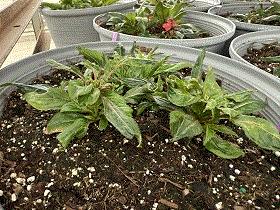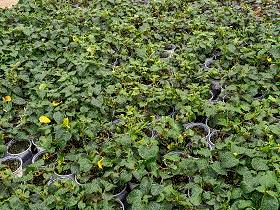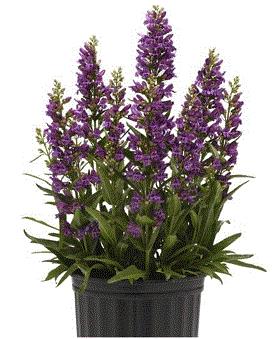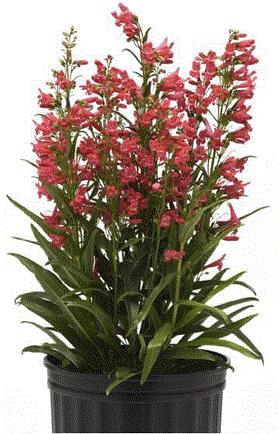Look Out for Broad Mites
While catching up with Dr. Janna Beckerman (Ornamentals Technical Specialist-Green Solutions Team at Envu Turf & Ornamentals North America) last week, she mentioned she has been observing broad mites on a few crops already this spring. After hearing this, I asked if she could provide an update on broad mites for the newsletter. Here’s what she put together for us.
Broad Mites
Many growers are battling Broad mites (Polyphagotarsonemus latus) this spring. The nasty little buggers are often found in spring greenhouses and shade houses feeding on begonias (angel wing and Reiger), geranium (zonal and ivy), gerbera daisies, fuchsia, hydrangea, New Guinea impatiens, pittosporum, torenia, verbena and ornamental peppers (they like it zesty!).
|

Fig. 1
|

Fig. 2
|
Broad mites are smaller than most spider mites [0.1-0.2 mm (1/130th of an inch and smaller)] and semi-transparent. They prefer cool temperatures with high humidity, and like to hide in buds, leaf axils and plant crevices, avoiding direct sunlight, and the paparazzi—which is why getting a good look at them, let alone a photo, is a challenge! When scouting for broad mites, look for malformed terminal buds, flower buds, and deformed, stunted growth on susceptible host plants (Fig. 1). Their toxic saliva causes curling, shortened petioles, and distorted growth—symptoms that might be confused with nutrient deficiencies, herbicide injury or even infection by virus (Fig. 2).
Because broad mites are very small, a conclusive diagnosis is easier to make by observing their eggs. These tiny eggs (80 µm long—3/1000th of an inch!) are football-shaped, dimpled like a golf ball, with opaque, white spots, which makes them easier to identify since they don’t move.
There are a number of miticides and natural enemies available to growers for spider mites, but very few of them are effective against broad mites. Better management of spider mites has provided an opening (and banquet!) for broad mites. Preventative applications of miticides that control both spider and broad mite, used in rotation, are recommended for the most susceptible crops (New Guinea impatiens, begonia, ivy, salvia and ornamental peppers). For a spider AND broad mite specific rotation, start with Savate (IRAC 23), which is translaminar, allowing it to get into those little crevices and buds that other miticides can’t reach. Follow with Shuttle, (IRAC 20D), Akari/Sanmite/Magus (IRAC 21A—choose one!), Avid (IRAC 6) or a horticultural oil (IRAC UNM).
Fig. 3
Remember that Savate (and Kontos) are not recommended for geranium (Fig. 3), spike (Dracaena), some varieties of roses, and peperomia! For those crops, skip the Savate and go to Shuttle. Be sure to include a good spreader (Induce, Capsil, Silwet 77, etc.) with your miticides to improve coverage and efficacy.
Dr. Beckerman—Thanks for putting together this broad mite update for the newsletter. I appreciate everything you do for the industry.

Echinacea Fringe Festival

When I saw this new introduction from Terra Nova Nurseries, I couldn’t wait to share it with you. There’s nothing like
Echinacea Fringe Festival in the marketplace. Unlike traditional coneflowers, the flowers of Fringe Festival do not have cones; instead, the blooms are absolutely covered with masses of pink petals. It’s cold hardy to Zone 4 and has attractive pine green strap-shaped leaves. Give this novelty a try.
New Intros from Darwin Perennials
Speaking of new introductions, my Ball Publishing colleagues have started their journey traveling through California and visiting the Spring Trials venues. They visited Darwin Perennials on Wednesday—here’s a couple of the new Darwin Perennials introductions they saw.
Penstemon Summit Sweets
|

Summit Sweets Purple
|

Summit Sweets Ruby
|
Summit Sweets is one of two new series of penstemon Darwin Perennials is introducing this year (the other is the Mountain Treats series—I’ll cover it in the near future). Summer Sweets has two colors available in 2026—
Purple and
Ruby—with more colors planned in the future. It’s a tall variety, reaching 2.5 to 3 ft. tall when blooming and the flowers nicely cover the spikes from the base of the plant all the way to the top. Hardy to Zone 5a.
Gaillardia Guapa
Darwin Perennials introduced a new series of gaillardia called Guapa Flamenco with two cultivars:
Bicolor and
Red. They each reach approximately 16 in. tall and cover themselves with attractive flowers beginning in the late spring. These are cold hardy to Zone 5a.

CAST 2025 Coverage

If you’re like me and were unable to attend the Spring Trials this year but don’t want to miss all the great introductions, Ball Publishing has your back and is visiting every stop, getting the dirt on all the new intros. You can catch their
daily write-ups in the Acres of buZZ! newsletter and their daily video coverage on the GrowerTalks YouTube channel CAST Playlist.
Survey Says
The subject lines reminds me of the times I’ve enjoyed watching and playing along with the Family Feud on television. Proven Winners recently published results from an extensive survey they sent to more than 14,000 gardeners across the United States and Canada. The results of the survey provide valuable insights into the purchasing behaviors, preferences and trends in the perennial plant market.
Key findings include:
1. Repeat Purchases and Robust Spending
-
A significant 64% of respondents reported purchasing perennials multiple times per year, indicating a strong trend of repeat visits to garden retailers.
-
Spending on perennials remains robust, with 73% of respondents stating they spent more or the same amount in 2024 compared to previous years.
2. Quality and Color Drive Decision Making
-
Quality is paramount for gardeners, with 43% of respondents citing quality as the most important factor in their purchasing decisions.
-
Color plays a crucial role, with 86% of respondents considering flower or foliage color when selecting perennials. Purple emerged as the most popular color, with 42% of respondents expressing a preference for purple perennials.
3. Strong Fall Sales
-
While spring remains the peak season for perennial purchases, with 89% of respondents buying in April, May and June, fall is also significant. Nearly half of respondents reported purchasing perennials in September or October.
4. Independent Garden Centers Lead the Market
-
Independent garden centers continue to dominate the market with 81% of respondents reporting they purchased perennials from an IGC in 2024. Additionally, 73% of respondents rely on their local nursery or garden center for information on new perennials. See the chart above.
5. Social Media’s Influence On Younger Gardeners
-
Social media is a vital source of information for younger gardeners, with 61% of respondents aged 18-30 and 64% of respondents ages 31-45 using social media to discover new perennials, compared with a rate of 32% with respondents 66+. This highlights the importance of a strong online presence for engaging the next generations of gardeners.
6. Top Perennial Preferences
-
Echinacea, salvia and hosta are the top three favorite perennials among respondents.
Bottom line: The perennial segment of our industry appears strong with customers spending the same or more on perennials in 2024 than they did in 2023 and with the majority of customers buying perennials multiple times per year. Based on these results, 2025 looks promising.





My email is paul@opelgrowers.com if you have any comments, article suggestions or if you'd just like to say hello.
Best regards,

Paul Pilon
Editor-at-Large—Perennial Pulse
Director of Growing—Opel Growers
This email was received by you and 34,279 other fine subscribers!
If you're interested in advertising in Perennial Pulse, contact Kim Brown ASAP and she'll hook you up.